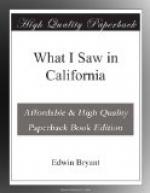The narrative of Lieut. Emory, of his journey from this point across the Desert of California, becomes highly interesting and characteristic.
“November 26.—The dawn of day found every man on horseback, and a bunch of grass from the Colorado tied behind him on the cantle of his saddle. After getting well under way, the keen air at 26 deg. Fahrenheit made it most comfortable to walk. We travelled four miles along the sand butte, in a southern direction; we mounted the buttes and found a firmer footing covered with fragments of lava, rounded by water, and many agates. We were now fairly on the desert.
“Our course now inclined a few degrees more to the north, and at 10, A.M., we found a large patch of grama, where we halted for an hour, and then pursued our way over the plains covered with fragments of lava, traversed at intervals by sand buttes, until 4, P.M., when, after travelling 24 miles, we reached the Alamo or cotton-wood. At this point, the Spaniards informed us, that, failing to find water, they had gone a league to the west, in pursuit of their horses, where they found a running stream. We accordingly sent parties to search, but neither the water nor their trail could be found. Neither was there any cotton-wood at the Alamo, as its name would signify; but it was nevertheless the place, the tree having probably been covered by the encroachments of the sand, which here terminates in a bluff 40 feet high, making the arc of a great circle convexing to the north. Descending this bluff, we found in what had been the channel of a stream, now overgrown with a few ill-conditioned mesquite, a large hole where persons had evidently dug for water. It was necessary to halt to rest our animals, and the time was occupied in deepening this hole, which, after a strong struggle, showed signs of water. An old champagne basket, used by one of the officers as a pannier, was lowered in the hole, to prevent the crumbling of the sand. After many efforts to keep out the caving sand, a basket-work of willow twigs effected the object, and, much to the joy of all, the basket, which was now 15 or 20 feet below the surface, filled with water. The order was given for each mess to draw a kettle of water, and Captain Turner was placed in charge of the spring, to see fair distribution.
“When the messes were supplied, the firmness of the banks gave hopes that the animals might be watered, and each party was notified to have their animals in waiting; the important business of watering then commenced, upon the success of which depended the possibility of their advancing with us a foot further. Two buckets for each animal were allowed. At 10, A.M., when my turn came, Captain Moore had succeeded, by great exertions, in opening another well, and the one already opened began to flow more freely, in consequence of which, we could afford to give each animal as much as it could drink. The poor brutes, none of which had tasted water in forty-eight hours, and some not for the last sixty, clustered round the well and scrambled for precedence. At 12 o’clock I had watered all my animals, thirty-seven in number, and turned over the well to Captain Moore. The animals still had an aching void to fill, and all night was heard the munching of sticks, and their piteous cries for more congenial food.




